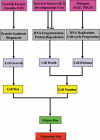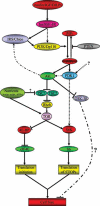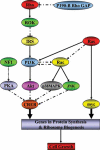Molecular mechanism of size control in development and human diseases
- PMID: 21483452
- PMCID: PMC3203678
- DOI: 10.1038/cr.2011.63
Molecular mechanism of size control in development and human diseases
Abstract
How multicellular organisms control their size is a fundamental question that fascinated generations of biologists. In the past 10 years, tremendous progress has been made toward our understanding of the molecular mechanism underlying size control. Original studies from Drosophila showed that in addition to extrinsic nutritional and hormonal cues, intrinsic mechanisms also play important roles in the control of organ size during development. Several novel signaling pathways such as insulin and Hippo-LATS signaling pathways have been identified that control organ size by regulating cell size and/or cell number through modulation of cell growth, cell division, and cell death. Later studies using mammalian cell and mouse models also demonstrated that the signaling pathways identified in flies are also conserved in mammals. Significantly, recent studies showed that dysregulation of size control plays important roles in the development of many human diseases such as cancer, diabetes, and hypertrophy.
Figures



Similar articles
-
Regulation of organ size: insights from the Drosophila Hippo signaling pathway.Dev Dyn. 2009 Jul;238(7):1627-37. doi: 10.1002/dvdy.21996. Dev Dyn. 2009. PMID: 19517570 Review.
-
Hippo signaling: a hub of growth control, tumor suppression and pluripotency maintenance.J Genet Genomics. 2011 Oct 20;38(10):471-81. doi: 10.1016/j.jgg.2011.09.009. Epub 2011 Sep 23. J Genet Genomics. 2011. PMID: 22035868 Review.
-
Expression of Drosophila FOXO regulates growth and can phenocopy starvation.BMC Dev Biol. 2003 Jul 5;3:5. doi: 10.1186/1471-213X-3-5. Epub 2003 Jul 5. BMC Dev Biol. 2003. PMID: 12844367 Free PMC article.
-
Organ Size Control: Lessons from Drosophila.Dev Cell. 2015 Aug 10;34(3):255-65. doi: 10.1016/j.devcel.2015.07.012. Dev Cell. 2015. PMID: 26267393 Free PMC article. Review.
-
Control of organ growth by patterning and hippo signaling in Drosophila.Cold Spring Harb Perspect Biol. 2015 Jun 1;7(6):a019224. doi: 10.1101/cshperspect.a019224. Cold Spring Harb Perspect Biol. 2015. PMID: 26032720 Free PMC article. Review.
Cited by
-
Fundamental origins and limits for scaling a maternal morphogen gradient.Nat Commun. 2015 Mar 26;6:6679. doi: 10.1038/ncomms7679. Nat Commun. 2015. PMID: 25809405 Free PMC article.
-
Maternal regulation of the vertebrate oocyte-to-embryo transition.PLoS Genet. 2024 Jul 25;20(7):e1011343. doi: 10.1371/journal.pgen.1011343. eCollection 2024 Jul. PLoS Genet. 2024. PMID: 39052672 Free PMC article.
-
Unraveling the Role of Ras Homolog Enriched in Brain (Rheb1 and Rheb2): Bridging Neuronal Dynamics and Cancer Pathogenesis through Mechanistic Target of Rapamycin Signaling.Int J Mol Sci. 2024 Jan 25;25(3):1489. doi: 10.3390/ijms25031489. Int J Mol Sci. 2024. PMID: 38338768 Free PMC article. Review.
-
Hippo Component TAZ Functions as a Co-repressor and Negatively Regulates ΔNp63 Transcription through TEA Domain (TEAD) Transcription Factor.J Biol Chem. 2015 Jul 3;290(27):16906-17. doi: 10.1074/jbc.M115.642363. Epub 2015 May 20. J Biol Chem. 2015. PMID: 25995450 Free PMC article.
-
Kidney atrophy vs hypertrophy in diabetes: which cells are involved?Cell Cycle. 2018;17(14):1683-1687. doi: 10.1080/15384101.2018.1496744. Epub 2018 Jul 30. Cell Cycle. 2018. PMID: 29995580 Free PMC article.
References
-
- Twitty VC, Schwind JL. The growth of eyes and limbs transplanted heteroplastically between two species of Amblytoma. J Exp Zool. 1931;59:61–86.
-
- Silber SJ. Growth of baby kidneys transplanted into adults. Surg Forum. 1975;26:579–582. - PubMed
-
- Kawarasaki H, Makuuchi M, Ishisone S, et al. Partial liver transplantation from living related donors. Transplant Proc. 1992;24:1470–1472. - PubMed
Publication types
MeSH terms
Grants and funding
LinkOut - more resources
Full Text Sources
Molecular Biology Databases
Miscellaneous

